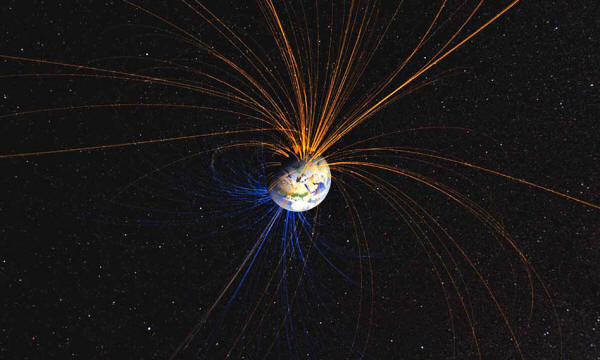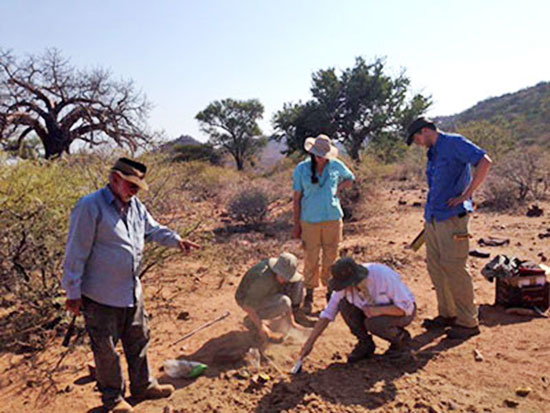|

by Lindsey Valich
February 27,
2018
from
UniversityOfRochester Website

Earth's geomagnetic field surrounds and protects
our
planet from harmful space radiation.
CC
BY-SA 2.0 photo
Flickr
user NASA Goddard Space Flight Center
Using new data gathered from sites in southern Africa, University of
Rochester researchers have extended their record of Earth's magnetic
field back thousands of years to the first millennium.
The record provides historical context to help explain recent,
ongoing changes in the magnetic field,
most prominently in an area in the Southern Hemisphere known as the
South Atlantic Anomaly (SAA).
"We've known for
quite some time that the magnetic field has been changing, but
we didn't really know if this was unusual for this region on a
longer timescale, or whether it was normal",
...says Vincent Hare,
who recently completed a postdoctoral associate appointment in the
Department of Earth and Environmental Sciences (EES) at the
University of Rochester, and is
lead author of a paper (New
Archeomagnetic Directional Records from Iron Age Southern Africa and
Implications for the 'South Atlantic Anomaly')
published in Geophysical Research Letters.
Weakening
magnetic field a recurrent anomaly
The new data also provides more evidence that a region in southern
Africa may play a unique role in magnetic pole reversals.
"We're getting
stronger evidence that there's something unusual about
the core-mantel boundary under Africa that could be having an
important impact on the global magnetic field."
The magnetic field that
surrounds Earth not only dictates whether a compass needle points
north or south, but also protects the planet from harmful
radiation from space.
Nearly 800,000 years ago,
the poles were switched:
north pointed south
and vice versa.
The poles have never
completely reversed since, but for the past 160 years, the strength
of the magnetic field has been decreasing at an alarming rate.
The region where it is
weakest, and continuing to weaken, is a large area stretching
from Chile to Zimbabwe called the South Atlantic Anomaly.
In order to put these relatively recent changes into historical
perspective, Rochester researchers - led by John Tarduno, a
professor and chair of EES - gathered data from sites in southern
Africa, which is within the South Atlantic Anomaly, to
compile a record of Earth's magnetic field strength over many
centuries.
Data previously collected
by Tarduno and Rory Cottrell, an EES research scientist,
together with theoretical models developed by Eric Blackman,
a professor of physics and astronomy at Rochester, suggest the core
region beneath southern Africa may be the birthplace of recent
and future pole reversals.
"We were looking for
recurrent behavior of anomalies because we think that's what is
happening today and causing the South Atlantic Anomaly," Tarduno
says.
"We found evidence
that these anomalies have happened in the past, and this helps
us contextualize the current changes in the magnetic field."
The researchers
discovered that the magnetic field in the region fluctuated from
400-450 AD, from 700-750 AD, and again from 1225-1550 AD.
This South Atlantic
Anomaly, therefore, is the most recent display of a recurring
phenomenon in
Earth's core beneath Africa that
then affects the entire globe.
"We're getting
stronger evidence that there's something unusual about
the core-mantel boundary under Africa that could be having an
important impact on the global magnetic field," Tarduno says.
A pole
reversal? Not yet, say researchers
The magnetic field is generated by swirling, liquid iron in Earth's
outer core.
It is here, roughly 1800
miles beneath the African continent, that a special feature exists.
Seismological data has revealed a denser region deep beneath
southern Africa called the
African Large Low Shear Velocity Province.
The region is located
right above the boundary between the hot liquid outer core and the
stiffer, cooler mantle. Sitting on top of the liquid outer core, it
may sink slightly, disturbing the flow of iron and ultimately
affecting Earth's magnetic field.
A major change in the magnetic field would have wide-reaching
ramifications; the magnetic field stimulates currents in anything
with long wires, including the electrical grid.
Changes in the magnetic
field could therefore cause electrical grid failures, navigation
system malfunctions, and satellite breakdowns. A weakening of the
magnetic field might also mean more harmful radiation reaches Earth
- and trigger an increase in the incidence of skin cancer.
Hare and Tarduno warn, however, that their data does not necessarily
portend a complete pole reversal.
"We now know this
unusual behavior has occurred at least a couple of times
before the past 160 years, and is part of a bigger long-term
pattern," Hare says.
"However, it's simply
too early to say for certain whether this behavior will lead to
a full pole reversal."
Even if a complete pole
reversal is not in the near future, however, the weakening of the
magnetic field strength is intriguing to scientists, Tarduno
says.
"The possibility of a
continued decay in the strength of the magnetic field is a
societal concern that merits continued study and monitoring."
This study was funded by
the US National Science Foundation.
In
the Field - "Archaeomagnetism" at work

Archaeologist Tom Huffman
of
the University of Witwatersrand in South Africa
helps John Tarduno and his students
orient and collect samples at a field site in southern Africa.
(University of Rochester photo / courtesy John Tarduno)
The researchers
gathered data for this project from an unlikely source:
ancient clay
remnants from southern Africa dating back to the early and
late Iron Ages.
As part of a field
called "archaeo-magnetism," geophysicists team up with
archaeologists to study the past magnetic field.
The Rochester team, which included several undergraduate
students, collaborated with archaeologist Thomas Huffman
of the University of Witwatersrand in South Africa, a leading
expert on Iron Age southern Africa.
The group excavated
clay samples from a site in the Limpopo River Valley, which
borders Zimbabwe, South Africa, and Botswana.
During the Iron Age in southern Africa, around the time of the
first millennium, there was a group of Bantu-speaking people who
cultivated grain and lived in villages composed of grain bins,
huts, and cattle enclosures. Draughts were devastating to their
agriculturally based culture.
During periods of
draught, they would perform elaborate ritual cleansings of the
villages by burning down the huts and grain bins.
"When you burn
clay at very high temperatures, you actually stabilize the
magnetic minerals, and when they cool from these very high
temperatures, they lock in a record of the earth's magnetic
field," Tarduno says.
Researchers excavate
the samples, orient them in the field, and bring them back to
the lab to conduct measurements using magnetometers.
In this way, they are
able to use the samples to compile a record of Earth's magnetic
field in the past.
| 


